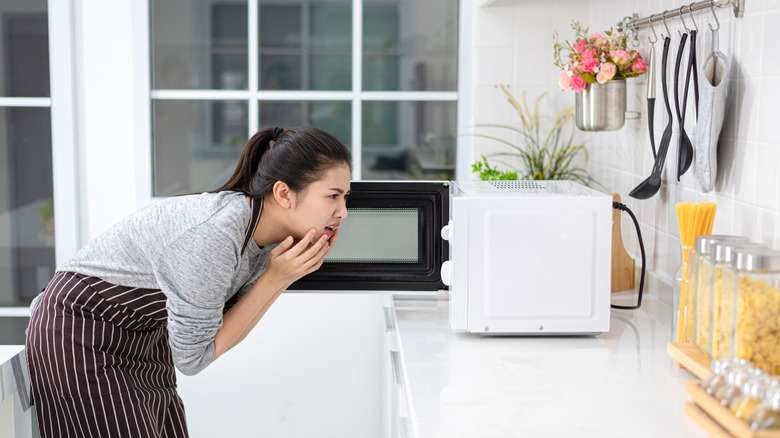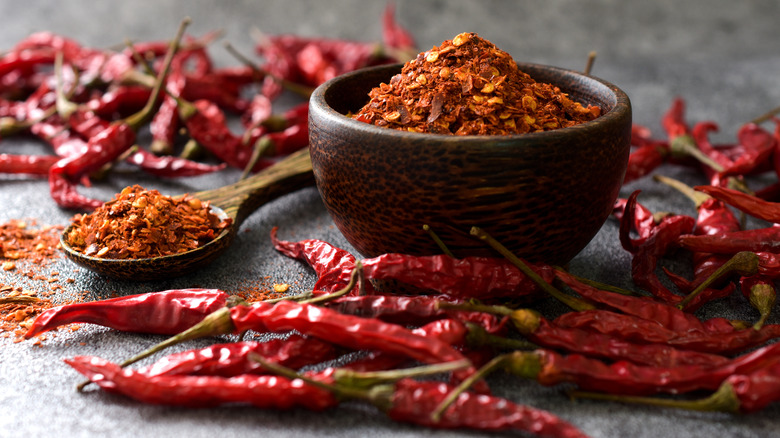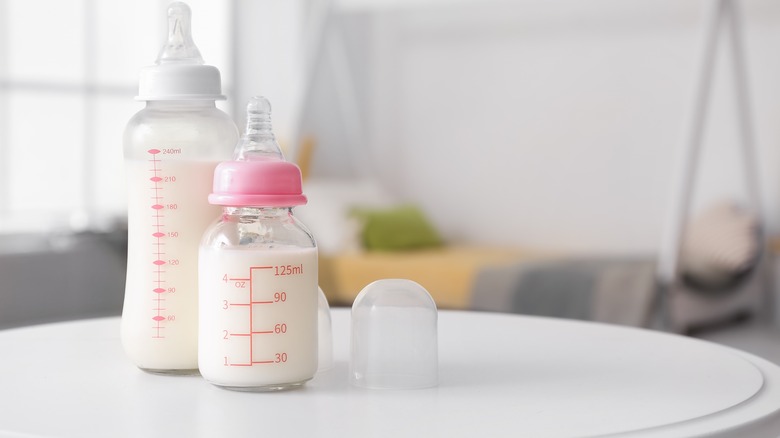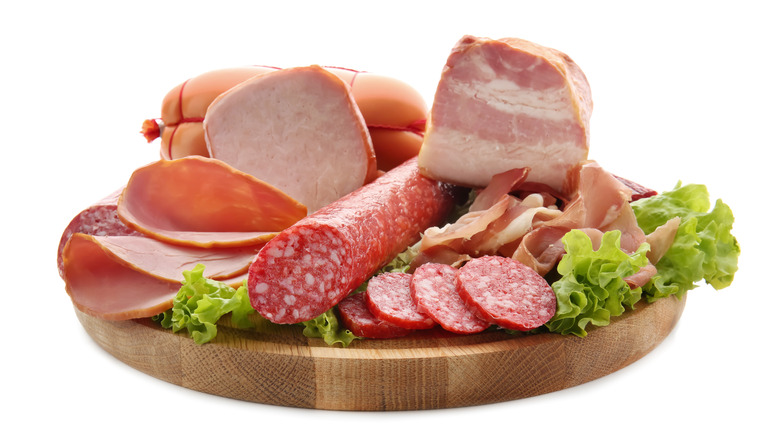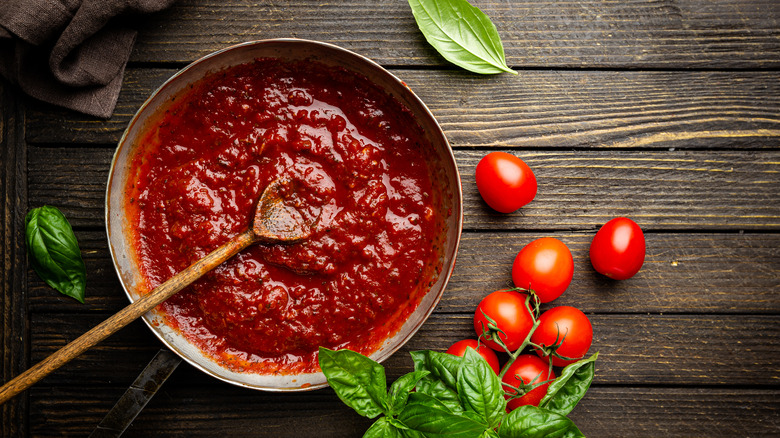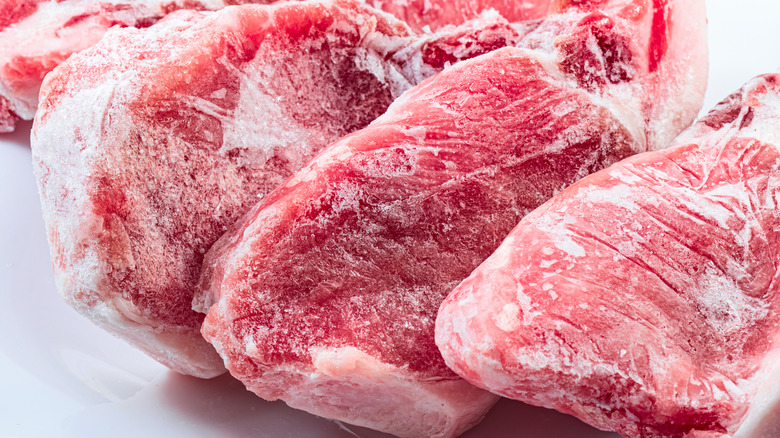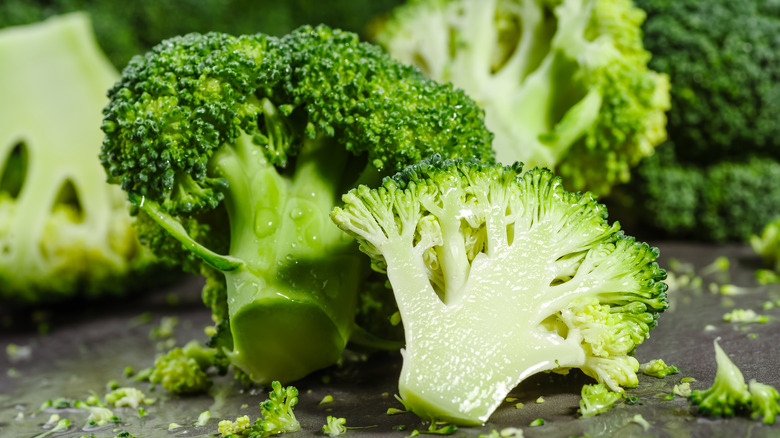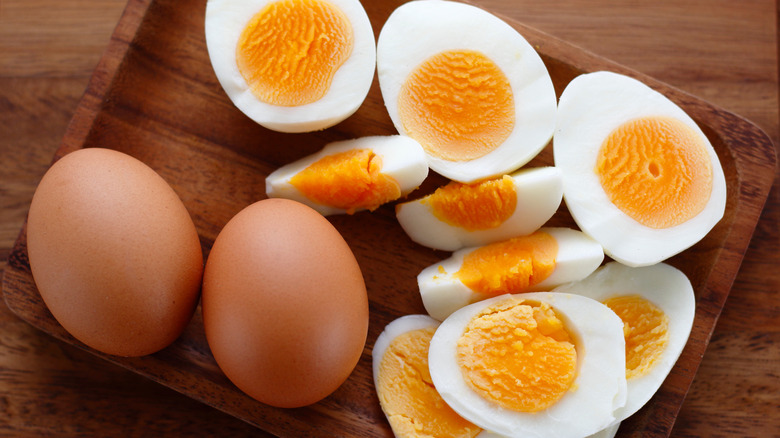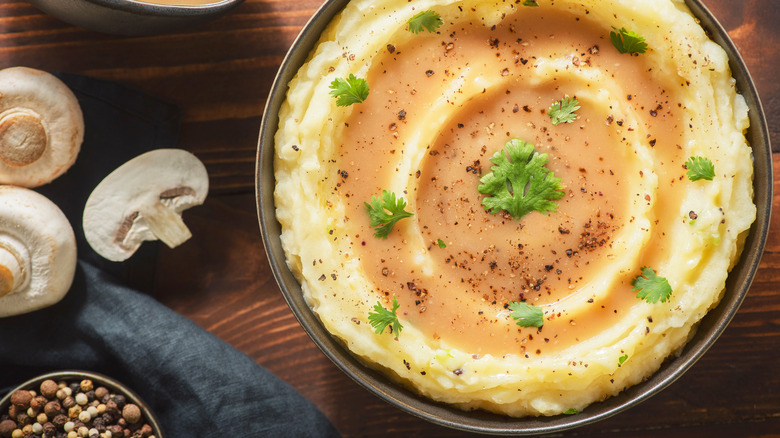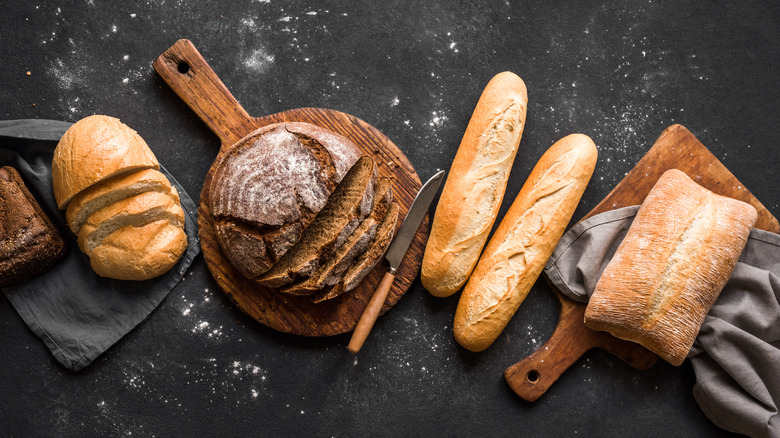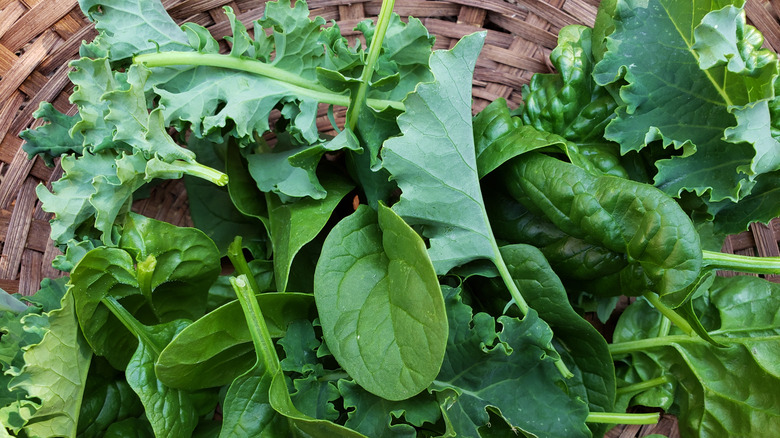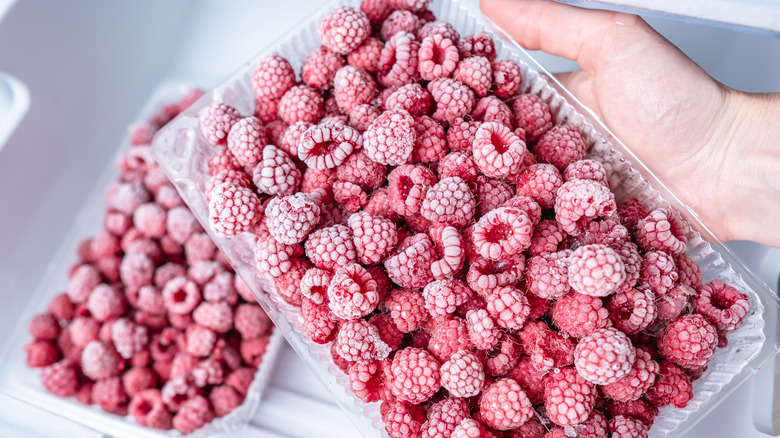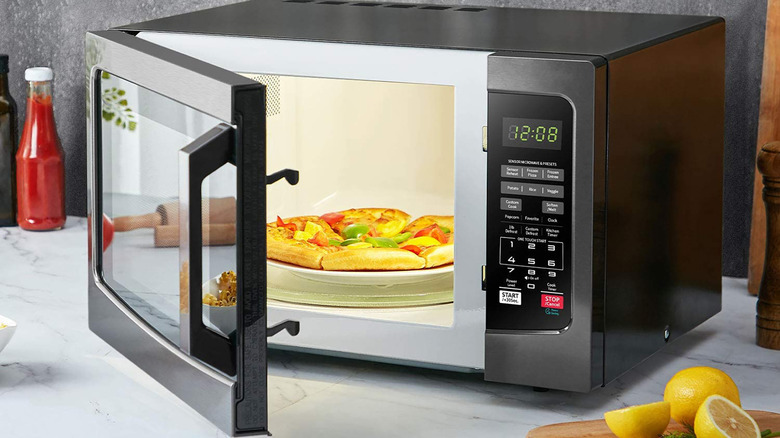16 Foods You Should Never Put In The Microwave
When it comes to essential kitchen appliances, the microwave is one that many people can hardly go a day without using. From warming up your forgotten tea that's gone cold and milk for your coffee to reheating last night's leftovers and cooking microwave dinners after an exhausting day at work, it's incredibly useful, convenient, and almost always the quicker option.
Useful as it is, though, there are some things that should never be placed in the microwave. You've probably heard about the fire and toxic dangers of items like Styrofoam, takeaway containers, cookware with metal trims, aluminum foil, and paper bags. As it turns out, there are foods and food products that are just as precarious in the microwave as these everyday items. You may even be surprised by how many of them you already microwave quite regularly. Whether it's the threat of chemical toxins drifting through your kitchen, possible explosions and burns, or your food being stripped of its nutritional content, one thing the following foods have in common is that they really shouldn't be nuked in your microwave. Keep reading to find out why.
Fish
As far as shared spaces and unspoken rules go, never reheat fish in the microwave is right up there with not stealing your coworkers' lunch. On this list however, it's not so much about fishy aromas wafting through the office as it is about your health and taste buds. Fish is a delicate food and using a microwave to either prepare or reheat will only dry it. Fortunately, it's also a food that you can explore eating cold, or use a pan or the oven, so you can still get your dose of all the good fats without risk of losing its delicate textures during the cooking process.
According to the U.S. Food & Drug Administration, how you store and handle your seafood is another crucial element of enjoying it and preserving its nutritional content. For instance, it's always a good idea to separate raw seafood from other ready-to-eat foods in order to prevent the spread of bacteria. It's also important to store it in temperatures below 40 F as soon as you've purchased it, and always prepare it thoroughly to avoid foodborne illness.
Chili peppers
Many chili lovers challenge themselves to eat hotter and hotter chili peppers. Researchers Paul Rozin and Deborah Schiller even associated this propensity toward spicy food with thrill seeking behavior. Much like the contained danger of a roller coaster ride, the physiological effect of having your mouth on fire produces a similar rush of adrenaline and those feel-good endorphins in the body. However, the thrill of this heat is only good for your taste buds, not the microwave. It may come as a surprise, but reheating hot peppers in the microwave could actually get you hurt.
According to the Liverpool Echo, capsaicin — the active compound that determines how spicy chili peppers are — acts as a chemical irritant for humans, hence creating that feeling of burning upon contact. Unlike other foods and items that might explode when they're heated in the microwave, chili peppers won't necessarily burst. Instead, capsaicin will be released and exposure to the fumes can cause your eyes and throat to have a burning sensation. While you may get an adrenaline rush, those endorphins are highly unlikely to follow.
Breast milk
With all the responsibility that comes with parenting while still tending to a full life, there are plenty of hacks that can be useful. For many parents, one such hack is to pump and freeze breast milk for their babies (via the CDC). When things get busy, the milk can then be thawed, heated, and given to the baby. As with most other foods, it would be quick and easy to simply put breast milk in the microwave, however this could pose a danger to your little one.
Per the Food and Drug Administration, studies have indicated that putting breast milk (and formula) in the microwave could heat the milk unevenly, thus creating "hot spots" that can burn your baby's sensitive tongue and throat. More traditional methods of heating like running hot tap water over the bottle or setting it in water heated in a pan on the stove until the temperature is baby perfect will alleviate this risk.
Processed meat
The convenience of chucking a hot dog in the microwave for a quick lunch is undeniable, especially when you don't have the time or energy to think up an elaborate meal (never mind actually preparing it). Now, we've all probably done this without sparing a single thought to whether or not it was even a good idea. But putting processed meats in the microwave is a resounding no-no.
Research highlighted in the study "Lipids in Health & Disease" indicates that "microwaving and oven grilling resulted in higher production of COPs in processed meat as compared with other cooking methods." An additional study published in " Food Control" reveals that the development of these COPs "have been known to be more injurious to arterial cells than pure cholesterol and are more directly connected to the development of atherosclerosis and coronary heart disease." Processed meats are already riddled with preservatives, and COPs can hardly be avoided when it comes to animal products, but you're still better off pulling out the frying pan or firing up the grill.
Grapes
It sounds a little curious that anyone would think of microwaving grapes, but if you've ever tried this roasted grape and red wine trifle recipe, you'll understand the notion isn't completely far-fetched. However, whether you're heating them up as a snack or for an addition to some of your favorite meals, it's still safer to roast your grapes in the oven instead of trying to give them a quick blitz in the microwave. Not only would you not get the same effect, but as it turns out, microwaving grapes can be a potential fire hazard.
According to Smithsonian Magazine, if you put grapes that are cut in half into the microwave, they act as an antenna that shoots electrical currents across the skin connecting them. This causes them to produce sparks of plasma — an ionized gas that is found in lightning and the sun, and essentially ignites a fire. A recent study found that this phenomenon is not only limited to halved grapes; it can occur in whole grapes as well other similarly sized, sphere-shaped foods including blackberries, gooseberries, and quail eggs.
Tomato-based pasta sauce
Sputtering, splattering sauce creating an explosive mess in the microwave is a nuisance, but the inconvenience of cleaning it all up is not the primary reason you should never microwave red pasta sauce. This mess can be attributed to two specific elements of your sauce: tomatoes and water. Tomatoes are a fruit that can help you stay hydrated since they're mostly made of water, which means once they're mangled down to make a sauce, you're left with a combination of low viscosity water (liquid that flows easily) and higher viscosity fibrous bits of the rest of the tomato (this is the thick texture of your sauce).
So essentially, while your pasta sauce is being rapidly heated in the microwave, the fibrous bits increase in density, thus forcing the liquid that's now become steam to fight its way out. With all this drama waiting to unfold, you and your microwave are better off heating your leftover red pasta sauce in a saucepan over the stove.
Frozen meat
There's a shared familiarity in that sinking feeling you get when it dawns on you that you forgot to transfer the meat you planned to prepare for supper, from the freezer to the fridge. It seems there's a quick fix: Simply pop it in the microwave and set it to defrost so you can get to your cooking as soon as possible. Unfortunately microwave defrosting often causes some parts of the meat to start cooking while others remain frozen (via Michigan State University).
According to Cookist, defrosting meat in the fridge rather than the microwave is about more than heat distribution — it's also about bacterial growth. When defrosted in the fridge, the cold temperature slows bacterial growth in your meat. In the microwave however, the temperature of the meat can rise to a point where bacterial growth multiplies. If you absolutely must use the microwave, you should cook your meat immediately after defrosting it.
Broccoli
As far as vegetables go, broccoli is among those that take a regular whirl in the microwave. However, how much of the nutritional value you preserve in the process boils down to the finer details. An article published in the "Journal of the Science of Food and Agriculture" shows that cooking broccoli in the microwave strips it of up to 97% of its flavonoids (the compounds that hold broccoli's anti-inflammatory properties). This is one-third more damage than is done by boiling.
On the other hand, a 2019 study that explored the impact of temperature, cooking time, and whether or not the broccoli was cooked in water found that when it's microwaved the nutritional value is not lost. The findings even suggested that microwaving better preserved the flavonoids. This, however, applied to a single minute of cooking time, so if you prefer your broccoli cooked through rather than al dente, you should probably keep your florets far away from the microwave and stick with steaming for your best nutritional bet.
Whole hard-boiled eggs
You might get away with nuking scrambled eggs but you should never microwave whole hard-boiled eggs. The results can be so dangerous that someone filed a lawsuit against a restaurant with claims of a microwaved hard-boiled egg exploding in his mouth, causing burns and hearing damage (via IFL Science).
While the lawsuit was settled out of court, researchers Anthony Nash and Lauren von Blohn looked into this by conducting their own experiments. They found that while some eggs exploded inside the microwave, approximately 30% of the eggs exploded only after they were taken out of the microwave and pierced. They also noted that regardless of whether or not the eggs exploded after being placed in water and heated for three minutes in the microwave, the yolks were much hotter than the water in which they were placed. This is definitely not worth discovering after you've bitten into the egg itself.
Leftover mushrooms and potatoes
Ah, the unmatched versatility of both potatoes and mushrooms. Whether paired together or not, few things compare to the comfort of leftover roast potatoes or mushrooms that have been soaked in a flavorful sauce overnight. When it comes to reheating potatoes, simply zapping them in the microwave is not the primary source of concern. Rather, it's important that they're appropriately cooled and stored so they don't become a health hazard when you give them a whirl later.
According to the USDA, when potatoes are sealed and left at room temperature for a while, instead of immediately storing them in the fridge, Clostridium botulinum — a bacteria that causes food poisoning, can grow. Mushrooms are similar in that they also need to be stored in the fridge within two hours after they're cooked, per StillTasty. This will prevent their protein structure and enzymes from disintegrating and also resulting in food poisoning, especially if you're planning on reheating them in the microwave later.
Bread
Microwaving bread may not pose any threats to your health and safety, but the awful taste and texture deems it worthy of a mention. According to The Spruce Eats, the reason bread that's microwaved simply disintegrates into a chewy mess has to do with sugar. The starch in flour contains sugar molecules that melt and thus soften the bread when heated. Unfortunately, as soon as it cools down again, those sugar molecules recrystallize. This results in a chewy, hard piece of bread. You'll especially know this if you've ever popped a slice of fresh bread into the microwave and hoped for a crispy piece of toast in return.
Per New Scientist, the mechanics of making toast in the microwave can be likened to starting a fire using a boiling pot of water. If you don't have a traditional toaster, simply use a hot pan to get those sides nice and toasty.
Chicken
While chicken is included in the necessary precautions around defrosting meat above, here we are specifically focusing on the dangers of cooking chicken in the microwave. In 2008, the USDA's Food Safety and Inspection Service had to issue a public health warning after 32 people across 12 different states contracted salmonellosis from consuming chicken that had been cooked in microwaves (via Medical News Today). Salmonellosis is a gastrointestinal infection that's caused by the salmonella bacteria. It can be especially life-threatening to children, elderly individuals and anyone who is immunocompromised.
While you may not defrost your chicken in the microwave, it's still important to exercise caution if you're going to cook it using the microwave in order to alleviate the risk of foodborne illnesses. One way to do this is by using a food thermometer to check that the temperature inside the chicken exceeds 165 F. It's at this temperature point that any bacteria that may be present in the meat will be killed.
Water for tea
How often have you mindlessly heated up your tea in the microwave because it had gone cold? For most people, this is an easy habit to pick up. You might reheat your cup several times; maybe you even forgo the kettle altogether, throw a tea bag and tap water in a mug, and nuke it in the microwave.
The surprising thing about tea however, is that different types need their water set at different temperature points. Water for green tea (this includes matcha) and white tea should be between 170 F and 180 F. Herbal tea should be at 210 F, while oolong and rooibos tea should be 200 F or hotter (via Real Simple and Smithsonian Magazine). Unlike most electrical kettles that are made to heat water to 212 F, there's no way of telling how hot microwaved water is, which could result in overheated water and a wonky tasting cup of tea.
Raw kale and other leafy greens
Reheating cooked greens shouldn't cause a stir in your kitchen. But as one NPR writer discovered when they tried to make kale chips in the microwave after their oven broke, raw greens can send some sparks flying. There seems to be some science behind this. Raw leafy greens are generally high in minerals such as iron, magnesium, and selenium — the same minerals as those found in pieces of metal.
Because microwaves possess both electric and magnetic fields, you only need a tiny bit of metal to light up the electric field. As such, just as a forgotten fork on your plate in the microwave might spark up as soon as it starts whirring, so too will these greens. Left long enough, these sparks could actually catch fire, so it's safer to stick to your already cooked greens as the minerals have already been reduced.
Frozen berries
As we noted above, grape-sized, sphere-shaped food items that contain a lot of water are a fire hazard in the microwave. Also, the minerals found in raw, leafy greens can produce a similar effect to what you get when you put metal cutlery inside it. Although frozen berries are an extension of both of these, there's another reason you should avoid putting them in the microwave.
According to the Plants for Human Health Institute, while antioxidants found in berries can help to prevent oxidative stresses that cause disease, when they are microwaved for five minutes, this capacity is diminished. So the next time you want to incorporate frozen berries in your favorite dish or baked goods, rather than blitzing them in the microwave, you can thaw them in the fridge if you have a little time to spare. Otherwise you can simply use them as they are. They might taste slightly different, but your body will be better for it.
Any foods that have already been reheated in the microwave
When it comes to leftovers, microwave reheating, and your health, the customary sniff test is probably not going to be the best determinant of whether or not the food is still good to consume. Fortunately, there are some general outlines about how to handle leftovers. BBC Good Food advises to avoid reheating or refreezing leftovers if they've already been reheated or thawed once. Fridge leftovers should be consumed within two days while frozen leftovers that have thawed should be eaten within 24 hours. And ensure you reheat your food until piping hot to avoid bacteria from multiplying.
Ultimately, food safety is the highest priority in your kitchen. It's important to remember that every reheat lowers the quality of your food a little bit more, but armed with the knowledge above as well as your own gut, you always get to decide what's best for you, and what might be more suited to the compost heap.
